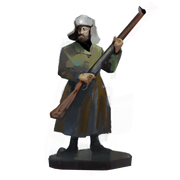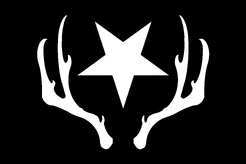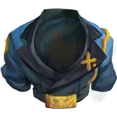The Antecentennial Revolution is an event in Disco Elysium.
History[ | ]
The Antecentennial Revolution—also known as the Turn-Of-The-Century Revolution,[1] World Revolution,[2] or Civil War (within Revachol)[3]—was a series of interisolary conflicts primarily between the Communists, known as the Communards, and the Moralintern and royalty. It began in Graad, in '02,[4] sparked in part by a virulent prion pandemic, called "tzaraath."[5] It ended in '08 within Graad and '10 within Revachol.[6]
40 million people died in the revolution. By the end, nearly all communists and anarchists were wiped out by Coalition forces.[7] Before that, however, communists and anarchists killed two million people within the Insulinde, and Joyce Messier claims that Mazovianism led to the deaths of fifteen million people in Graad.[8]
Graad and Kraz Mazov[ | ]
Kraz Mazov (a pseudonym)[9] is cited as the father of scientific communism and the leading figure during the revolution. Some people say he not only heavily influenced the revolution, but also sparked it.[10] He led the Graad side and headed the Eleven Day Government, which was overthrown in '08[6] Mazov is said to have committed suicide during the final siege of the Graadian capital.[9]
Samara and Ignus Nilsen[ | ]
The Hsin-Yao Commune was the center of the Revolution within Samara. At one point of the war, they supplied firearms to the Commune of Revachol.[11]
Ignus Nilsen, from Vaasa[12] and Kraz Mazov's most trusted lieutenant, helped establish the People's Republic of Samara. Nilsen is often cited as the second most important figure in the Antecentennial Revolution, following Kraz Mazov, and is called the "Evangelist of the Revolution" by admirers.[13][14]
Nilsen is well known for both his war crimes and Nilsenist-Mazovianism.[14] During the communists' retreat from Graad to Samara, he personally ordered up to 12,000 prisoners of war to be impaled on sharpened spruce trees in the Samaran backcountry. From then on, he was known as the "Apocalyptic Shrike" by his enemies.[15] Nilsen also pioneered infra-materialism.[14]
The People's Republic of Samara still exists to this day, though it is implied that they have fallen in disrepair.[16]
Revachol[ | ]
King Filippe III was ruler of the Suzerain of Revachol, capital of the world at the time, before the revolution. Due to his profligacy and maladministration, he began the financial downfall of Revachol. He is credited as the one responsible for the fall of the monarchy within the Insulinde.[17]
In the 7th of March in '02, the new Commune of Revachol transmitted the Le Décret de Mars (The March Decree) to world governments, announcing their creation.[18] Their army was the Insulindian Citizens Militia, or the ICM.[19]
At this point, Guillaume "Le Lion"[20] was suzerain. His Ikeira Operation forcefully united the people in the southeastern part of Le Petit Continent, collectively known as the Ikeira tribes, under the Revacholian banner.[21]

Figurine of a Communist Solider
However, Guillaume fled the Insulinde before the fighting got too bad, becoming a successful venture capitalist in Graad. His nephew, Frissel the First, took his place.[22][20] Frissel was eventually killed by the communists,[22][23] placing Revachol under communist control.
Coalition forces then stepped in to eradicate the communists. On the 13th of May in '08, Coalition airships shelled Martinaise, who were unable to defend themselves.[24] This was one part of Operation Death Blow; the other two locations that the Coalition captured were Stella Maris and the Delta.[25] At the time, there were 50 million people on Caillou alone: all indiscriminately bombed by Coalition.[26]
Two years later, in '10, the Commune of Revachol fell,[6] formally ending with the Revacholian Instrument of Surrender.[27] Julia Dobreva and Jean Abadanaiz, known as the "Revolutionary Lovers" were the Dual Commissars of Revolution on the Insulindian front. They disappeared at the end of the Commune and were found dead on a beach in Ozonne in '35. Forensic analysis suggested suicide by poison.[28]
Sometime during the Commune's existence, construction on the People's Pile, a Type U particle decay generator, began. After the Commune's fall, it was finished by leftists and immediately failed, releasing radioactive waste into River Esperance.[29]
In the wake of the Revolution, the Revachol Citizens Militia formed to restore order to Revachol under the rule of the Coalition government.[30]
Culture and Iconography[ | ]

Star-And-Antlers
Flags[ | ]
Star-And-Antlers[ | ]
The symbol of the communists were the star-and-antlers, developed in the sixth decade of the last century.[31] The star is upside down to symbolize the toppling of the old order, and was a symbol of social democrats before the communists.[32] The wreath, or crown, of antlers represents a society that could exist in accord with the natural world, while also ruling it.[33] White was chosen because it was the color of peace,[34] and eventually became heavily associated with communists.[35]
Sevenfold Sun Miracle[ | ]
The flag of the Suzerainty of Revachol displays the Sevenfold Sun Miracle, an optical atmospheric anomaly that the first settlers of the Insulinde saw. Six suns orbit a larger one in the center.[36]
Anthems[ | ]
There were three anthems of the Revolution. In Graad, it was "Brave Children, Favourites of History." In Samara, or Hsin-Yao, it was "Boy with a Scythe / Golden Sun." In Revachol is was "La Revacholière."[37] La Revacholière may have involved lyrics about shooting rabbits.[38]
Ace's High[ | ]
The Ace's High (a high five) is a custom invented by aerostatic brigades during the Revolution, used to celebrate success in Revachol. Despite the fall of the Commune, the gesture has spread across the world. One can add an Ace's Low to the gesture (a low five) by turning around after the High and waiting for another.[39]

An Insulindian Lily
Insulindian Lily[ | ]
The Insulindian Lily, called "May bells" or "Lucille's Tears" during the Revolution, is a spring flower with six white petals forming a bell-shaped crown. Girls pinned these flowers on revolutionary soldiers before sending them to battle, though the custom originated within the Suzerain's army.[3][40]

Royalist carabineer jacket
Uniforms[ | ]
Revacholian royalist soldiers wore a blue uniforms, gold coats, gold caps, and orange trousers. Due to their brightness, however, they were eventually switched to camouflage.[41]
It is implied that most of revolutionaries did not keep a uniform.[42] However, revolutionary air brigade pilots wore orange bomber jackets.[43] One is worn by Kim Kitsuragi.[44] Revolutionary airmen (the mechanics and engineers) wore similar black bomber jackets.[45]
Revolutionary Matronyms[ | ]
Graad uses patronyms for surnames. However, the Graad revolutionaries started using matronyms instead, derived from the mother's name, seeing patronyms as a chauvinist custom. The custom spread to Revachol, but was overturned after the end of the Revolution.[46]
References[ | ]
- ↑ ENCYCLOPEDIA - The original was blown apart by communards, then further damaged during the landing of the Coalition's airships during the Turn-Of-The-Century Revolution. When Martinaise was levelled.
- ↑ THE DESERTER - "It was sent to us by our brothers in the Hsin-Yao Commune. Military aid." He pats the rifle.
YOU - "The Hsin-Yao Commune?"
THE DESERTER - "You heard me. It's good now. Like chalk wiped from the board."
ENCYCLOPEDIA - He's right. Almost no one remembers there was a third metastasis of the World Revolution, in the Safre Empire extinguished in '06. - ↑ 3.0 3.1 YOU - "Who pinned them? Which side?"
KIM KITSURAGI - "The revolutionaries: so the communards and the anarchists. White's their colour. But the custom started in the Suzerain's army so it held meaning for the kingsmen too."
KIM KITSURAGI - "It's about girls and boys more than *sides*. Girls sending off boys who are going to their deaths -- then also dying themselves in the ruins, from dysentery and consumption. It's a symbol of the Civil War." - ↑ JOYCE MESSIER - "The Revolution began in '02, on the isola of Graad, though by the end nearly the whole world had gotten involved."
- ↑ JOYCE MESSIER - "It wasn't a *who*, but a *what*. A pandemic of tzaraath, a particularly virulent prion disease, which the authorities in Graad proved unable to contain. Then Mazov came along and overthrew the government."
- ↑ 6.0 6.1 6.2 YOU - "Where did it spread from there?"
JOYCE MESSIER - "From Revachol and Graad? Not far. The world managed to cauterize itself. Mazov's government was overthrown in '08, and the Coaltion crushed the Revachol commune two years later. It was *The End*." - ↑ YOU - "Who got shot in the head?"
JOYCE MESSIER - "Those would be the communists. Generally speaking, 40 million people got shot in the head during the World Revolution. But the communists -- they *all* got shot in the head."
JOYCE MESSIER - "Oh, and the anarchists too! They shot them well. So well one forgets they even existed."
YOU - "You could say they got *totally* shot in the head."
JOYCE MESSIER - "Indeed. They piled them in mass graves in Ozonne and, well --that's the last anyone heard of those people." - ↑ YOU - "Did the communists and the anarchists shoot back?"
JOYCE MESSIER - "Did they ever. Before they got shot themselves, they shot two million people."
YOU - "Sounds like they should have shot more people in the head then."
JOYCE MESSIER - "Don't worry, Kraz Mazov shot fifteen million people in the head. But that was all the way over in Graad." - ↑ 9.0 9.1 ENCYCLOPEDIA - Kraz Mazov (nom de guerre), was an economist and a theoretical historian. He was a leading figure in the Graad side of the Turn-of-the-Century Revolution, where he headed the Eleven Day Government. Mazov is considered the father of scientific communism (Mazovian thought or Mazovianism).
YOU - Yum yum, tell me more.
ENCYCLOPEDIA - He killed himself. - ↑ KIM KITSURAGI - "He's known as the father of scientific communism, also known as Mazovianism. His theories about economic history greatly influence -- some would even say *sparked* -- the Antecentennial Revolution."
- ↑ KIM KITSURAGI - "A Samaran rifle... How did you get hold of one?" THE DESERTER - "It was sent to us by our brothers in the Hsin-Yao Commune. Military aid." He pats the rifle.
- ↑ ENCYCLOPEDIA - When Vaasan communist revolutionary Ignus Nilsen was in hiding, he stayed in a hut on the boreal plateau for ten months.
- ↑ YOU - "I know who Kraz Mazov is, but who is this 'Ignus Nilsen' guy?"
STEBAN, THE STUDENT COMMUNIST - "Only Kraz Mazov's most trusted lieutenant, the Evangelist of the Revolution, and the founding father of the People's Republic of Samara."
STEBAN, THE STUDENT COMMUNIST - "He *also* happens to be the greatest communist theorist after Mazov himself. It was Nilsen who first postulated the existence of ideological plasm, which forms the basis of infra-materialist theory." - ↑ 14.0 14.1 14.2 A BRIEF LOOK AT INFRA-MATERIALISM - Known to his numerous admirers as the 'Evangelist of the Revolution' and to his even-more-numerous enemies as the 'Apocalyptic Shrike', Ignus Nilsen remains one of the most controversial and fascinating figures to emerge in the years of the Antecentennial Revolution, second only to Kras Mazov himself.
A BRIEF LOOK AT INFRA-MATERIALISM - During his unparalleled life, he helped guide a revolution in one country and found a new state in another. Along the way, he committed some of the most notorious war crimes in an era famed for its atrocities. - ↑ ENCYCLOPEDIA - Oh, right. During the disastrous retreat from Graad to Samara, Nilsen personally ordered up to 12,000 prisoners of war impaled on sharpened spruce trees in the Samaran backcountry. Thereafter his opponents began referring to him as the 'Apocalyptic Shrike'.
ENCYCLOPEDIA - Today, Nilsen's reputation has waned in most parts of the developed world, with the exception of the People's Republic of Samara (SRV), where he is recognized as a founding father. His political philosophy is a variant of Mazovianism called Nilsenist-Mazovianism. - ↑ ENCYCLOPEDIA - The People's Republic of Samara (SRV) is a product of Revachol's sister revolution on the isola of Graad. It's known as a severely degenerated rogue state.
- ↑ YOU - Who is this?
HORSEBACK MONUMENT - A silver plaque on the statue's pedestal reads: 'I am Filippe III, the Squanderer, the Greatest of the Filippian Kings of Revachol; Son of Filippe II, the Opulent; Father of Filippe IV, the Insane.' YOU - What did this king do?
ENCYCLOPEDIA - Even by the standard of the Filippian kings, Old Sumptuous Filippe was known for his profligacy.
YOU - In what way?
ENCYCLOPEDIA - Well, he blew through the whole national treasury, starting the decline of one of the penultimate century's greatest superpowers: the Suzerain of Revachol...
ENCYCLOPEDIA - His own maladministration foreshadowed the fall of the monarchy during the Antecentennial Revolution, an end to his family line and the monarchy on the Insulindian isola. - ↑ YOU - "What did the revolutionaries do with those advanced tape computers?"
TRANT HEIDELSTAM - "They used them for military communications," he says, while his son looks up idly chewing on the corner of his würm-themed colouring book. "But also to write and send out press releases. The most notorious example being Le Décret de Mars."
YOU - "What was that?"
TRANT HEIDELSTAM - "What's the March decree? I mean the radio transmission sent out to new agencies and world governments by the newly-created Commune of Revachol on the 7th of March in the year '02."
ENCYCLOPEDIA - A short-lived legislative foundation for a short-lived utopia. - ↑ ENCYCLOPEDIA - Insulindian Citizens Militia, the official name of the communards' army. The army of the Revolution.
- ↑ 20.0 20.1 RENÉ ARNOUX - He catches your glance and nods. "This is the uniform of the Royal Carabineers in service of Frissel the First, Guillaume *Le Lion*, and the valiant King filippe the Fifth before him.
- ↑ ENCYCLOPEDIA - 'The Ikeira Operation' was a seven-year campaign during which Suzerain Guillaume's army forcefully united the people in the southeastern part of Le Petit Continent, collectively known as the Ikeira tribes, under the Revacholian banner.
- ↑ 22.0 22.1 YOU - "Anyone else get shot in the head -- on the opposing side?"
JOYCE MESSIER - "Oh, lots of people. Even the king got shot in the head, or thrown beneath a horse. Or drowned. Accounts differ. It was unceremonious." She shakes her head. "Just as well -- he wasn't actually the king. Just the king's nephew."
JOYCE MESSIER - "The real king abdicated and lived out a long and productive life as a venture capitalist in Graad." YOU - "Smart king."
JOYCE MESSIER - "Yes, King Guillaume had a nose for bad PR. He ran before it -- what is the expression -- *went down*? Anyway, Gil got out alive and his nephew Frissel got shot in his place..." - ↑ THE DESERTER - "Calm down? I'm not angry..." His hand still trembles. "I *adore* him. He reminds me of everything we fought for. At least we killed that Frissel and his kingsmen..." He's overtaken by a coughing fit.
- ↑ THE DESERTER - "May the 13th, '08, 22 years ago," he looks north. "The horizon was black with Coalition airships. Their petroleum rose to the sky and it looked like... like it *formed* the clouds. Storm clouds. When they started shelling it was... dark magic."
- ↑ RENÉ ARNOUX - "Martinaise was used as one of the three footholds in Revachol during Operation Death Blow in '08. The other two are off in Stella Maris and the Delta." He points to the northeast.
- ↑ THE DESERTER - "*Death Blow*. you're one of them. Tell me, who speaks like that? We had 50 million people on Caillou alone..."
- ↑ YOU - "The communards signed the Revacholian Instrument of Surrender."
THE DESERTER - "Liberal reactionaries signed that instrument -- traitors, who should have been burned alive..." He draws his breath. "I answer to the Communist Party." - ↑ ENCYCLOPEDIA - Wow, this one's a deep cut. Julia Dobreva and Jean Abadanaiz, popularly known as the 'Revolutionary Lovers', served as Dual Commissars of Revolution on the Insulindian front during the Antecentennial Revolution. their forbidden love, as well as their disappearance during the final collapse of the Revacholian commune only contributed to their mystique...
ENCYCLOPEDIA - Their remains were discovered on a beach in Ozonne in '35. Subsequent forensic analysis suggested suicide by poison. - ↑ YOU - "The People's Pile? What's that?"
BIRD'S NEST ROY - "A bad idea. Some poor leftists built a particle decay generator in hopes of bringing affordable electricity to under-served communities. It malfunctioned. Radioactive waste everywhere, probably some of it in *you*, too."
ENCYCLOPEDIA - The People's Pile was a Type U particle decay generator that failed immediately after entering service, releasing radioactive waste into River Esperance.
YOU - Why is it called the *People's* Pile?
ENCYCLOPEDIA - Construction began during the Commune of Revachol. The *people* continued work on it after the Commune fell -- they wanted a cheap source of energy for Revachol West. - ↑ KIM KITSURAGI - "the RCM was formed by the Coalition government to restore order in the International Zone after the Revolution. So we did. Now we attempt to *maintain* that order, no more, no less." His gaze is absently fixed on a window below that just went dark.
- ↑ ENCYCLOPEDIA - That isn't *just* a five-pointed star -- it's an inverted white pentagram cradled in a wreath of antlers. The iconography of communism, in other words.
YOU - Inspect the symbol closer.
ENCYCLOPEDIA - The star-and-antlers was developed in the sixth decade of the last century and quickly adopted by Mazov and the communards during the Revolution...
ENCYCLOPEDIA - Even today, half a century after, the star-and-antlers retains the ability to evoke hope, disappointment, and fear in equal measure. - ↑ YOU - Why is the star upside down?
ENCYCLOPEDIA - To symbolize the toppling of the old order.
ENCYCLOPEDIA - Also, some social democrats were already using it. - ↑ YOU - What's the deal with the antlers?
ENCYCLOPEDIA - The wreath of antlers represents a natural crown. It was about building a society that could exist in accord with the natural world -- and at the same time above it. - ↑ YOU - Why white?
ENCYCLOPEDIA - Because white is the colour of peace. - ↑ RHETORIC - People sometimes complain there are no real communists left in Martinaise, but you can smell their presence. They're out there, waiting for you to join them!
ENCYCLOPEDIA - Incidentally, during the waning days of the Antecentennial Revolution, a number of Revacholian communards constructed elaborate hideouts in abandoned root cellars, hollowed-out tree trunks, and even residential sewage tanks. This latter phenomenon gave rise to the early anti-communist slogan, 'The Future's Bright When You Flush Out the White!' - ↑ ENCYCLOPEDIA - This is the flag of Revachol the Suzertainty.
YOU - What's with the sun?
ENCYCLOPEDIA - This isn't just one sun, but there are little suns dancing around the big sun. This is the Sevenfold Sun Miracle.
YOU - What's the Sevenfold Sun Miracle?
ENCYCLOPEDIA - It's an optical atmospheric anomaly the first settlers saw. Happens in cold weather: six small suns around the big one. This complex halo-phenomena is how old Revachol got its flag. - ↑ YOU - "What is La Revacholière?"
THE DESERTER - "It is the anthem of the World Revolution." His eyes remain fixed on the sky. "One of three."
THE DESERTER - "In Graad they sang 'Brave Children, Favourites of History' and in Hsin-Yao it was..." He struggles to remember, then gives up. "...some Samaran shit, I guess."
ENCYCLOPEDIA - In Hsin-Yao they sang "Boy with a Scythe / Golden Sun." - ↑ THE DESERTER - "How did it go..." He looks at his gun on the ground and shakes his head slowly.
THE DESERTER - "Something about shooting *rabbits,* I don't know... I can't remember. It doesn't matter. It's gone now." - ↑ ENCYCLOPEDIA - The Ace's High -- a custom invented by the aerostatic brigades during the Revolution -- is used to celebrate success in Revachol. Especially in sports. The gesture has spread across the world, despite the defeat of the revolutionaries themselves.
INTERFACING - You could add an Ace's Low to it, if you like. By turning your back after the High and waiting for another. - ↑ DRIED WILDFLOWER - Six crumbling petals rest on your palm. They're white, a bell-shaped crown.
YOU - "What is this, Kim?"
KIM KITSURAGI - "This is the Insulindian Lily." The lieutenant corrects his glasses. "Called 'May bells' or 'Lucille's tears' during the Revolution. Girls used to pin these on soldiers before sending them off to battle.
ENCYCLOPEDIA - This flower is a spring flower, but it's a bit early for that, isn't it? - ↑ YOU - Inspect the blue uniforms.
KNICK-KNACKS STAND - They're not all blue. These figurines also wear gold coats and caps, complimented by orange trousers. They are variously posed, wielding swords and rifles with bayonets.
YOU - "Wait, this looks like René, the old guy who was playing petanque."
KIM KITSURAGI - "This is what the loyalists looked like, yes." He inspects the figurine. "At first. Then they wised up and got camouflage." - ↑ KNICK-KNACKS STAND - This set of soldiers isn't meant to look impressive. A few have rifles, but most of them carry pistols -- some even shovels and tall sticks. YOU - (Point at the figurines in rags.) "Are these even soldiers?"
BIRD'S NEST ROY - "You're probably talking about the revolutionaries, yes?" the man behind the glass answers. "Yes -- they are soldiers. Revolutionary soldiers."
BIRD'S NEST ROY - "I think their poverty has been exaggerated for effect. When you place them next the royalists, it doesn't seem like they could possibly win." - ↑ (ZA/UM Atelier) Kim Kitsuragi's orange pilot jacket, modeled after those worn by air brigades during the Revolution. Most of those brigades were ripped to shreds or burnt to cinders above the city of Revachol, the larger island it sits upon, or the ocean that surrounds it. Pilots used the inner pockets of their jackets to store logbooks and tool kits. Kim honours this function by using one of the pockets to carry his trusty notebook, where it lies close to his heart. It’s a sentimentality, but Kim feels centred when wearing this jacket. He leaves it on when he sits down for Volta.
- ↑ YOU - "Kim, you're wearing a revolutionary air brigade jacket, aren't you?"
- ↑ (ZA/UM Atelier) Kim Kitsuragi’s black airman's jacket. Originally worn by mechanics and engineers during the Revolution, most of whom went down with the aerostatics they served on. Its bulky silhouette and durable materials provide resistance to bangers and the weather alike. The black reminds Kim of Seol, though he’s never been there. For special occasions only.
- ↑ YOU - "A Revolutionary matronym?"
TRANT HEIDELSTAM - "The custom started in Graad, where they have patronyms: Krasovich, Larsovich, etc. The revolutionaries saw this as a chauvinist atavism so they used matronyms, derived from the mother's name, instead."
TRANT HEIDELSTAM - "This man would be Lilian's son -- Lilianovich." He turns to Vicquemare. "The custom was overturned after the revolutions failed, but not before making it to Revachol."
